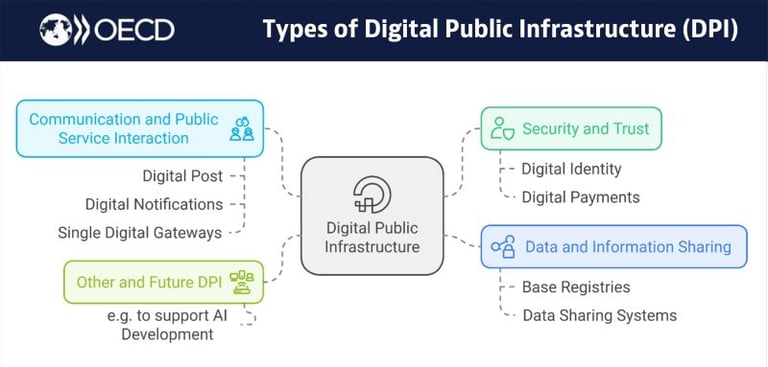SELFOU: SPICE-UP YOUR WORK-LIFE!
Digital Public Infrastructure (DPI)
Digital Transformation - Archives
Have you ever wondered what was the difference between Digital Transformation and Digital Public Infrastructure? Emerys Shoemaker explains three takeaways from a Caribou Digital - UNDP convening to identify DPI specific risks.
Read full article
Takeaway 1: Countries don’t think of DPI; instead, they think of systems. So the distinction between DPI and ‘generic’ digital transformation is more of a ‘how’ difference rather than a ‘what’ difference.
Takeaway 2: The distinction of DPI is the implications for development pathways and choice.
Takeaway 3: DPI’s complex business models present risks to both owners and systems.
David Eaves shares a case study from India on Digital Public Infrastructure at the local level, just published on the UCL Institute for Innovation and Public Purpose (IIPP)'s website (https://www.ucl.ac.uk/bartlett/public-purpose/publications/2025/jan/indias-national-urban-governance-platform)
This case "India’s National Urban Governance Platform Leveraging digital infrastructure thinking to build smart city capabilities at scale" looks at the work of the India Administrative Service (IAS) - Government of India who built on the non-profit eGov Foundation to offer a set of digital building blocks to digitizing local government services at scale.
Andres Raieste presents - based on an OECD report available here a state of DPI 24-25. Enjoy! Please note that his post includes all the necessary hyperlinks.
State of DPI in 2024 going into '25. The recently published policy paper by OECD Public Governance on Digital Public Infrastructure is a good read for all digital government leaders. DPI is necessary for enabling modern digital governments and digital-first public services. The paper suggests system of thinking for #DPI with examples from various countries with existing DPI, analyzing different funding mechanisms and governance models.
Globally, DPI as a "package of digital government enablers" has been growing for several years to fight the widening digital gap well covered earlier this year in UN e-Government Survey 2024 (link: https://lnkd.in/d--WTeTn). International donors specifically have taken interest (see the excellent post by Gates Foundation on DPI - https://lnkd.in/dvyRB9pq), supported by international surveys and research such as the excellent DPI map (.org) by UCL Institute for Innovation and Public Purpose (IIPP) and David Eaves (see above), or more widely baseline requirements provided by UNDP and United Nations Office for Digital and Emerging Technologies in the DPI Safeguards guideline (link here: https://lnkd.in/dUCAsgsN). Another example is GovStack, an international coalition supporting the development of DPIs by facilitating specifications and best-practices.
In Europe, many nation-states already have various levels of DPI developed and many regulations and EU-level programs are in place to focus development of cross-border use-cases, such as EIDAS for developing cross-EU identity wallet or data spaces initiatives pushed by EU and Gaia-X Association for Data and Cloud (AISBL), to name a few.
However, the debate is rising over the "public" - who should own DPI, how to fund and govern DPI? The questions related to digital sovereignty. This has paved way for concepts such as Digital Commons (see here: https://lnkd.in/dwbuKWMZ and here: https://lnkd.in/dYsH4XJn by NGI Commons), a concept comparable to UN Digital Public Goods idea.
A good and successful case-study here is how multilateral organizations, such as Nordic Institute for Interoperability Solutions (NIIS), have been way of developing, co-funding and governing DPI, a collaboration started by Estonian and Finnish governments for governing the co-development of x-Road, the government interoperability framework.
For us, being long-time core developers of DPI systems (x-Road, digital identity systems, single digital gateways etc, in Europe, North America, Middle-East and Africa), 2024 was a very busy year, but will be even busier in 2025. With some elements of DPI also being key enablers for use of AI in digital public services, we surely will see much more adoption of DPI in 2025 and forward.
Digital Public Infrastructure (DPI)
Digital Transformation - Archives
Felipe Gonzalez Zapata provides us with types of #DIP that exist among #OECD member and partner countries, and their purposes
"For years, OECD countries have been developing, deploying, and overseeing DPI as a cornerstone of their #DigitalGoverment efforts. DPI systems play a foundational role in designing and delivering #PublicServices that meet user needs, as highlighted in the OECD Recommendation on Human-centred Public Administrative Services. Increasingly, DPI is also driving digital economic growth, with systems like #DigitalIdentity enabling seamless, secure interactions.
Our latest policy paper categorises DPI into four key types based on the foundational needs they address:
➡️ DPI for security and trust, such as digital identity and digital payments.
➡️ DPI for data and information sharing, including interoperable base registries and data-sharing systems.
➡️ DPI for communication and public service interaction, like digital post, notification services, and single digital gateways.
➡️ Other and future DPI, emerging to meet evolving needs, including #AI applications.
More to come!
#OECD Public Governance #CarlosSantiso #CeciliaEmilsson #ArturoRivera #SeongJuPark #RicardoZapata #JulianOlsen #MarcoDaglio


Barbara Ubaldi shares an OECD report on Digital public infrastructure for digital governments and comments:
